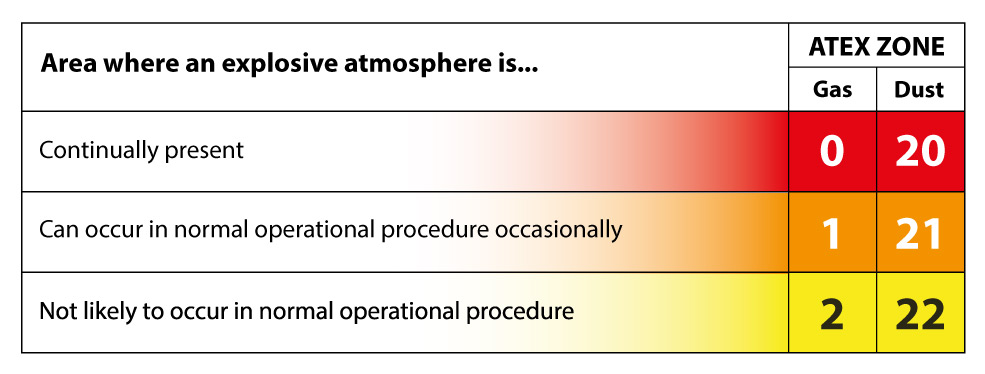This article will outline the different ATEX Zone Definitions and the categorised explosive atmospheres they relate to.
What is ATEX?
ATEX is part of the European Equipment Directive (ATEX 2014-34 EU), a French language acronym that closely translates into English as “Devices intended for use in explosive atmospheres”.
The ATEX 2014-34 EU directive is a manufacturing standard designed to ensure that individuals are protected against risk caused by dangerous substances. It specifically refers to the presence of flammable gasses and dust present in the air that can potentially cause an explosion.
Where would ATEX Zone Definitions be Applicable?
ATEX applies to any workplace that stores flammable or explosive materials, or (through normal operational procedures) generates combustible clouds of gas or dust that can build up quickly to dangerous levels.
What is an explosive atmosphere?
An explosive atmosphere can be defined as when certain flammable substances (in the form of gases, vapours, mist, or dust) become mixed with normal breathable air.
When this happens within a certain area (such as a confined space), it creates a dangerous environment where an imminent risk of explosion (or respiratory/personal harm) can occur.
Explosive atmospheres in the workplace can be caused by flammable gases, mists, vapours or by combustible types of dust:
Agricultural & Food Processing products: |
Metals & Wood: |
Various specks of dust such as: |
| Egg whites | Sawdust | Coal |
| Powdered milk | Aluminium | Sulphur |
| Corn-starch | Bronze | Pharmaceuticals |
| Sugar-Dust | Magnesium | Pesticides |
| Flour | Zinc | Graphite Powder |
| Grain | Toner | |
| Potato | Sugar-Dust | |
| Rice | ||
| Pesticides | ||
| Tobacco | ||
What are the ATEX Zone Definitions Zone classifications?
ATEX regulation states that workplaces must classify areas where explosive atmospheres are likely into the following zones:
ATEX Zone 0: Gas or vapour
An explosive gas atmosphere is likely to be present continuously or for long periods
ATEX Zone 1: Gas or vapour
Where an explosive gas atmosphere is likely to occur during normal operations
ATEX Zone 2: Gas or vapour
An area where an explosive gas atmosphere is not likely to occur during normal operations. If gas or vapour does occur, it will only exist for a short time only
ATEX Zone 20: Powder or dust
This applies to areas where atmospheres containing clouds of combustible dust will occur frequently or for extended periods of time
ATEX Zone 21: Powder or dust
This applies to areas where atmospheres containing a cloud of combustible dust will occur on occasion
ATEX Zone 22: Powder or dust
This applies to areas where atmospheres containing a cloud of combustible dust will occur rarely or for relatively short periods

Equipment must be ATEX approved
Companies must ensure the equipment used within any of the zones outlined in this article (under either ATEX 153 or Directive ATEX 114 is properly certified and therefore safe to use.
Without proper testing, any equipment used could potentially cause an explosion, even in the lowest risk areas such as Zone 2 / 22.
If you have any questions regarding ATEX Zones or would like an informal discussion regarding safety equipment, don’t hesitate to call our advisors on 02920 759 683 or use our contact form here.





